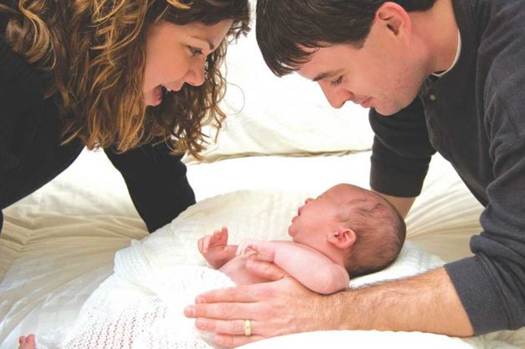It may
cause you some embarrassment, but when your child screams and clings to you at
the mere approach of Aunt Marge (or nearly any other unfamiliar person), he’s
actually responding in a very normal way. “Stranger anxiety is nothing more
than your child’s way of telling you that he prefers you over anyone else,”
explains Robert Needlman, M.D., F.A.A.P., associate professor of pediatrics at
Case Western Reserve University School of Medicine in Cleveland. “Humans are
born with the instinct to create strong emotional attachments to special people
in their lives, and the flip side of a strong emotional attachment is some anxiety
or shying away from other people.”

Your baby wants only a small circle of friends,
namely mom and dad
Needlman
says the “stranger danger” reaction occurs among almost all babies and often
appears at around 9 to 12 months of age. There is great variability
in when children begin to outgrow it, ¿is well as its severity, but many begin
to be more accepting at 2 '/a to 3 years
old. In the meantime, patience is paramount. “The key is to know your child,”
says Needlman. “If you have a very reserved child, don’t push it, but rather
respect his need for some time. You might say to a well-meaning adult, ‘If you
stand over there for a while and don’t talk directly to Johnny, pretty soon
he’ll be more comfortable.’”
The best
overall approach, he adds, is to present your child with small challenges that
he can handle. “You wouldn’t take a child with severe stranger anxiety to a
very boisterous party,” he says, “but you might take him to a quiet gathering
of one or two friends.”
A sneaky
culprit
Are you
having a hard time getting your newborn to latch on? Is nursing becoming
bite-your- lip painful? If so, your baby may have a condition called
Ankyloglossia or tongue tie. Affecting an estimated 4.8 percent of newborns,
tongue tie occurs when the frenulum, the thin piece of tissue that attaches the
tongue to the floor of the mouth, is too tight, restricting the tongue’s movement.
This can cause breastfeeding issues and poor weight gain for babies.
“Latching
on to the breast requires the baby to stick his tongue out and lift it up, and
tongue tie can hinder this,” explains M. Lauren Lalakea, M.D., an otolaryngologist
and clinical associate professor (affiliated) at Stanford University Medical
Center in Palo Alto, Calif. “Babies may gum the breast and not create the suction
necessary for a proper latch.” Interestingly, tongue tie does not cause
problems with bottle-fed babies because the same mechanics are not required.
To check
for the condition, look to see if your child’s tongue is heart- shaped when it
is sticking out; also see if it is difficult to lift up or seems tight against
the floor of his mouth. If you suspect he has tongue tie, see your
pediatrician; it may need to be treated in a simple office procedure called a
frenotomy, in which the frenulum is snipped to increase the tongue’s mobility.
Beware, however, that waiting too long may make for a slightly more
complicated procedure.
“Once a
baby is 4 to 5 months old,” Lalakea says, “a frenotomy usually needs to be done
in an operating room under anesthesia.” She explains that younger babies
tolerate the office procedure fairly well; older ones are more cognizant and
simply won’t like it.
Contraception
after baby
Planning on
using the same birth control as before you conceived? That may not be a smart
move. According to the U.S. Centers for Disease Control and Prevention (CDC),
there are potential safety issues with certain types of hormonal
contraceptives—especially in the first few weeks after having a baby.

Planning on using the same birth control as
before you conceived?
“One of the
main concerns in the immediate postpartum period is that women are at higher
risk for something called a venous thromboembolism, or a blood clot,” says
Naomi K.Tepper, M.D., M.P.H., a medical officer in the division of reproductive
health at the CDC. “If these women use birth control that contains
estrogen—which also raises the risk for blood clots—they’re at even higher
risk.”
Avoid
estrogen following delivery
In
guidelines released in 2011, the CDC advises that all women avoid estrogen
forms of birth control for the first 21 days after having a baby, when the risk
for a blood clot is the highest. These include combined birth control pills
(those that contain estrogen and progestin), the patch and the vaginal ring.
Women who have risk factors for developing blood clots—a history of
preeclampsia, a blood-clotting disorder or a Cesarean delivery; or being a
smoker, obese or age 35 and older, to name a few— are at even higher risk and
are advised not to use estrogen birth control for the first six weeks. If you
are nursing, avoid estrogen birth control for the first month because it might
affect your milk supply.
Your
best birth control options
Contraceptives
that contain only progestin are safe for all women even those who are
breastfeeding in the immediate postpartum period and indefinitely, says Tepper, who helped draft the guidelines. These include
progestin-only birth control pills; Depo-Provera (injections given every 12
weeks); Implanon (a small rod inserted under the skin of the arm that lasts for
three years but can be removed at any time); and Mirena (a hormonal IUD that is
effective for five years but also can be removed at any time). In addition, the
copper IUD, which does not contain any hormones, is safe and lasts for 10
years.
Whatever
type of contraceptive you’re considering, discuss it with your doctor or
midwife, preferably while you’re still pregnant and be sure to mention any
potential risk factors you may have.